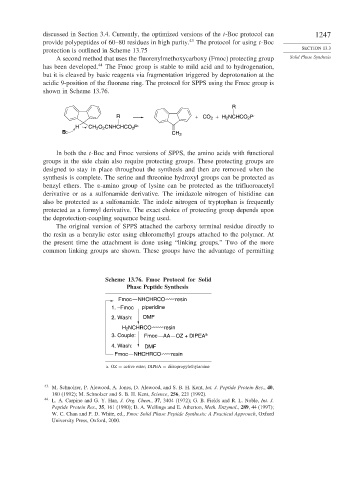Page 1271 - Advanced Organic Chemistry Part B - Reactions & Synthesis
P. 1271
discussed in Section 3.4. Currently, the optimized versions of the t-Boc protocol can 1247
provide polypeptides of 60–80 residues in high purity. 43 The protocol for using t-Boc
protection is outlined in Scheme 13.75 SECTION 13.3
A second method that uses the fluorenylmethoxycarboxy (Fmoc) protecting group Solid Phase Synthesis
has been developed. 44 The Fmoc group is stable to mild acid and to hydrogenation,
but it is cleaved by basic reagents via fragmentation triggered by deprotonation at the
acidic 9-position of the fluorene ring. The protocol for SPPS using the Fmoc group is
shown in Scheme 13.76.
R
R + CO 2 +H 2 NCHCO 2 P′
H CH 2 O 2 CNHCHCO 2 P′
B: CH 2
In both the t-Boc and Fmoc versions of SPPS, the amino acids with functional
groups in the side chain also require protecting groups. These protecting groups are
designed to stay in place throughout the synthesis and then are removed when the
synthesis is complete. The serine and threonine hydroxyl groups can be protected as
benzyl ethers. The -amino group of lysine can be protected as the trifluoroacetyl
derivative or as a sulfonamide derivative. The imidazole nitrogen of histidine can
also be protected as a sulfonamide. The indole nitrogen of tryptophan is frequently
protected as a formyl derivative. The exact choice of protecting group depends upon
the deprotection-coupling sequence being used.
The original version of SPPS attached the carboxy terminal residue directly to
the resin as a benzylic ester using chloromethyl groups attached to the polymer. At
the present time the attachment is done using “linking groups.” Two of the more
common linking groups are shown. These groups have the advantage of permitting
Scheme 13.76. Fmoc Protocol for Solid
Phase Peptide Synthesis
Fmoc NHCHRCO resin
1. –Fmoc piperidine
2. Wash: DMF
H 2 NCHRCO resin
3. Couple: Fmoc AA OZ + DIPEA a
4. Wash: DMF
Fmoc NHCHRCO resin
a. OZ = active ester; DIPEA = diisopropylethylamine
43 M. Schnolzer, P. Alewood, A. Jones, D. Alewood, and S. B. H. Kent, Int. J. Peptide Protein Res., 40,
180 (1992); M. Schnolzer and S. B. H. Kent, Science, 256, 221 (1992).
44
L. A. Carpino and G. Y. Han, J. Org. Chem., 37, 3404 (1972); G. B. Fields and R. L. Noble, Int. J.
Peptide Protein Res., 35, 161 (1990); D. A. Wellings and E. Atherton, Meth. Enzymol., 289, 44 (1997);
W. C. Chan and P. D. White, ed., Fmoc Solid Phase Peptide Synthesis: A Practical Approach, Oxford
University Press, Oxford, 2000.

